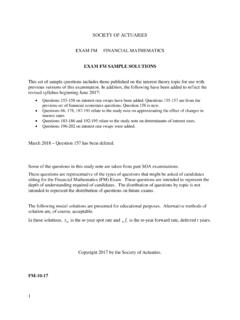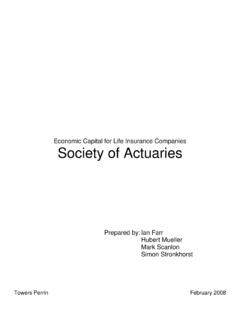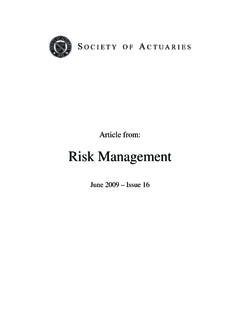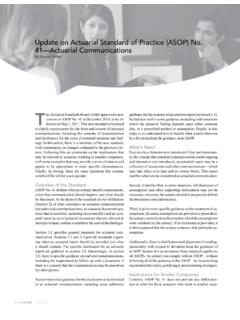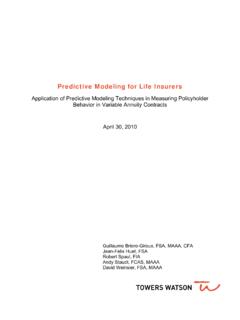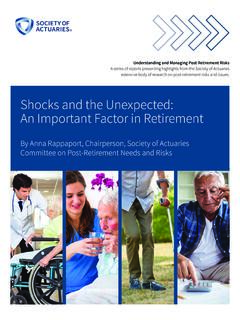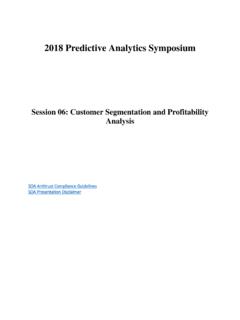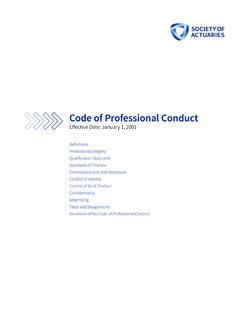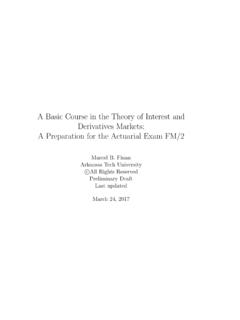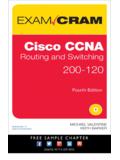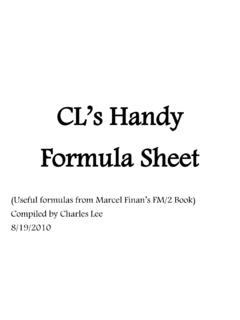Transcription of Exam FM Sample Questions - SOA
1 1 SOCIETY OF ACTUARIES exam fm FINANCIAL MATHEMATICS exam fm Sample Questions This set of Sample Questions includes those published on the interest theory topic for use with previous versions of this examination. In addition, the following have been added to reflect the revised syllabus beginning June 2017: Questions 155-158 on interest rate swaps have been added. Questions 155-157 are from the previous set of financial economics Questions . question 158 is new. Questions 66, 178, 187-191 relate to the study note on approximating the effect of changes in interest rates. Questions 185-186 and 192-195 relate to the study note on determinants of interest rates. Questions 196-202 on interest rate swaps were added. March 2018 question 157 has been deleted. Some of the Questions in this study note are taken from past SOA examinations. These Questions are representative of the types of Questions that might be asked of candidates sitting for the Financial Mathematics (FM) Exam.
2 These Questions are intended to represent the depth of understanding required of candidates. The distribution of Questions by topic is not intended to represent the distribution of Questions on future exams . Copyright 2017 by the Society of Actuaries. FM-09-17 2 1. Bruce deposits 100 into a bank account. His account is credited interest at an annual nominal rate of interest of 4% convertible semiannually. At the same time, Peter deposits 100 into a separate account. Peter s account is credited interest at an annual force of interest of . After years, the value of each account is the same. Calculate . (A) (B) (C) (D) (E) 2. Kathryn deposits 100 into an account at the beginning of each 4-year period for 40 years. The account credits interest at an annual effective interest rate of i. The accumulated amount in the account at the end of 40 years is X, which is 5 times the accumulated amount in the account at the end of 20 years.
3 Calculate X. (A) 4695 (B) 5070 (C) 5445 (D) 5820 (E) 6195 3 3. Eric deposits 100 into a savings account at time 0, which pays interest at an annual nominal rate of i, compounded semiannually. Mike deposits 200 into a different savings account at time 0, which pays simple interest at an annual rate of i. Eric and Mike earn the same amount of interest during the last 6 months of the 8th year. Calculate i. (A) (B) (C) (D) (E) 4. John borrows 10,000 for 10 years at an annual effective interest rate of 10%. He can repay this loan using the amortization method with payments of 1, at the end of each year. Instead, John repays the 10,000 using a sinking fund that pays an annual effective interest rate of 14%. The deposits to the sinking fund are equal to 1, minus the interest on the loan and are made at the end of each year for 10 years. Calculate the balance in the sinking fund immediately after repayment of the loan.
4 (A) 2,130 (B) 2,180 (C) 2,230 (D) 2,300 (E) 2,370 4 5. An association had a fund balance of 75 on January 1 and 60 on December 31. At the end of every month during the year, the association deposited 10 from membership fees. There were withdrawals of 5 on February 28, 25 on June 30, 80 on October 15, and 35 on October 31. Calculate the dollar-weighted (money-weighted) rate of return for the year. (A) (B) (C) (D) (E) 6. A perpetuity costs and makes end-of-year payments. The perpetuity pays 1 at the end of year 2, 2 at the end of year 3, .., n at the end of year (n+1). After year (n+1), the payments remain constant at n. The annual effective interest rate is Calculate n. (A) 17 (B) 18 (C) 19 (D) 20 (E) 21 5 7. 1000 is deposited into Fund X, which earns an annual effective rate of 6%. At the end of each year, the interest earned plus an additional 100 is withdrawn from the fund.
5 At the end of the tenth year, the fund is depleted. The annual withdrawals of interest and principal are deposited into Fund Y, which earns an annual effective rate of 9%. Calculate the accumulated value of Fund Y at the end of year 10. (A) 1519 (B) 1819 (C) 2085 (D) 2273 (E) 2431 8. Deleted 9. A 20-year loan of 1000 is repaid with payments at the end of each year. Each of the first ten payments equals 150% of the amount of interest due. Each of the last ten payments is X. The lender charges interest at an annual effective rate of 10%. Calculate X. (A) 32 (B) 57 (C) 70 (D) 97 (E) 117 6 10. A 10,000 par value 10-year bond with 8% annual coupons is bought at a premium to yield an annual effective rate of 6%. Calculate the interest portion of the 7th coupon. (A) 632 (B) 642 (C) 651 (D) 660 (E) 667 11. A perpetuity-immediate pays 100 per year. Immediately after the fifth payment, the perpetuity is exchanged for a 25-year annuity-immediate that will pay X at the end of the first year.
6 Each subsequent annual payment will be 8% greater than the preceding payment. The annual effective rate of interest is 8%. Calculate X. (A) 54 (B) 64 (C) 74 (D) 84 (E) 94 7 12. Jeff deposits 10 into a fund today and 20 fifteen years later. Interest for the first 10 years is credited at a nominal discount rate of d compounded quarterly, and thereafter at a nominal interest rate of 6% compounded semiannually. The accumulated balance in the fund at the end of 30 years is 100. Calculate d. (A) (B) (C) (D) (E) 13. Ernie makes deposits of 100 at time 0, and X at time 3. The fund grows at a force of interest 2100tt =, t > 0. The amount of interest earned from time 3 to time 6 is also X. Calculate X. (A) 385 (B) 485 (C) 585 (D) 685 (E) 785 8 14. Mike buys a perpetuity-immediate with varying annual payments. During the first 5 years, the payment is constant and equal to 10. Beginning in year 6, the payments start to increase.
7 For year 6 and all future years, the payment in that year is K% larger than the payment in the year immediately preceding that year, where K < At an annual effective interest rate of , the perpetuity has a present value of Calculate K. (A) (B) (C) (D) (E) 15. A 10-year loan of 2000 is to be repaid with payments at the end of each year. It can be repaid under the following two options: (i) Equal annual payments at an annual effective interest rate of (ii) Installments of 200 each year plus interest on the unpaid balance at an annual effective interest rate of i. The sum of the payments under option (i) equals the sum of the payments under option (ii). Calculate i. (A) (B) (C) (D) (E) 9 16. A loan is amortized over five years with monthly payments at an annual nominal interest rate of 9% compounded monthly. The first payment is 1000 and is to be paid one month from the date of the loan.
8 Each succeeding monthly payment will be 2% lower than the prior payment. Calculate the outstanding loan balance immediately after the 40th payment is made. (A) 6750 (B) 6890 (C) 6940 (D) 7030 (E) 7340 17. To accumulate 8000 at the end of 3n years, deposits of 98 are made at the end of each of the first n years and 196 at the end of each of the next 2n years. The annual effective rate of interest is i. You are given (1) +=. Calculate i. (A) (B) (C) (D) (E) 10 18. Olga buys a 5-year increasing annuity for X. Olga will receive 2 at the end of the first month, 4 at the end of the second month, and for each month thereafter the payment increases by 2. The annual nominal interest rate is 9% convertible quarterly. Calculate X. (A) 2680 (B) 2730 (C) 2780 (D) 2830 (E) 2880 11 19. You are given the following information about the activity in two different investment accounts: Account K Fund value Activity Date before activity Deposit Withdrawal January 1, 2014 July 1, 2014 X October 1, 2014 2X December 31, 2014 Account L Fund value Activity Date before activity Deposit Withdrawal January 1, 2014 July 1, 2014 X December 31, 2014 During 2014, the dollar-weighted (money-weighted) return for investment account K equals the time-weighted return for investment account L, which equals i.
9 Calculate i. (A) 10% (B) 12% (C) 15% (D) 18% (E) 20% 12 20. David can receive one of the following two payment streams: (i) 100 at time 0, 200 at time n years, and 300 at time 2n years (ii) 600 at time 10 years At an annual effective interest rate of i, the present values of the two streams are equal. Given , calculate i. (A) (B) (C) (D) (E) 21. Payments are made to an account at a continuous rate of (8k + tk), where 010t . Interest is credited at a force of interest 18tt =+. After time 10, the account is worth 20,000. Calculate k. (A) 111 (B) 116 (C) 121 (D) 126 (E) 131 13 22. You have decided to invest in Bond X, an n-year bond with semi-annual coupons and the following characteristics: (i) Par value is 1000. (ii) The ratio of the semi-annual coupon rate, r, to the desired semi-annual yield rate, i, is (iii) The present value of the redemption value is Given (1) +=, calculate the price of bond X.
10 (A) 1019 (B) 1029 (C) 1050 (D) 1055 (E) 1072 23. Project P requires an investment of 4000 today. The investment pays 2000 one year from today and 4000 two years from today. Project Q requires an investment of X two years from today. The investment pays 2000 today and 4000 one year from today. The net present values of the two projects are equal at an annual effective interest rate of 10%. Calculate X. (A) 5400 (B) 5420 (C) 5440 (D) 5460 (E) 5480 14 24. A 20-year loan of 20,000 may be repaid under the following two methods: (i) amortization method with equal annual payments at an annual effective interest rate of (ii) sinking fund method in which the lender receives an annual effective interest rate of 8% and the sinking fund earns an annual effective interest rate of j Both methods require a payment of X to be made at the end of each year for 20 years. Calculate j. (A) (B) (C) (D) (E) 25.
